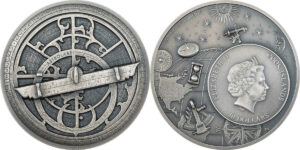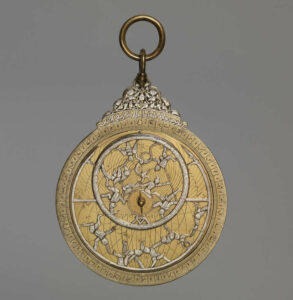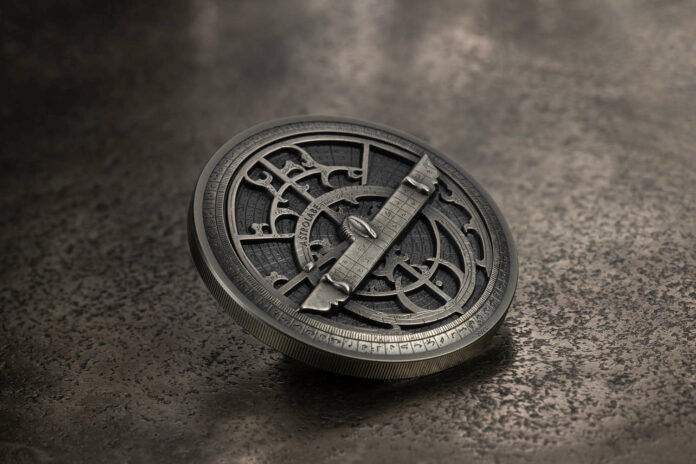The history of astronomical discoveries is also the history of measuring instruments, which have constantly evolved to suit the needs of humankind. An integral part of this history is the astrolabe, whose basic principle was developed as early as in late ancient times: the first astrolabe was described around 530 AD by a member of the Library of Alexandria. CIT dedicates a new 2 ounce silver coin in Antique Finish to this measuring instrument. As always with CIT, the coin is minted with the special technique smartminting® in an ultra high relief at B. H. Mayer’s Kunstprägeanstalt, Munich.

Description of the Coin
One side is designed in the form of an astrolabe; Arabic characters on the disk and the rete mounted on it, ASTROLABE on a circle of the rete, on the rim at the bottom the year 2023.
The other side features the portrait of Elizabeth II in a circle, below IRB (= Ian Rank-Broadley), around it ELIZABETH II 10 DOLLARS COOK ISLANDS. In the field a globe with degree grid and wind rose, above archaized depictions of stars, sun and moon. Measuring instruments such as sextant, sundial, hourglass and telescope distributed over the field. HISTORIC INSTRUMENTS at the upper left.
Background
The astrolabe became highly popular in the Arab world, where it provided both merchants and scientists with an enormous advantage. With the astrolabe, they could exactly determine the position of a celestial body, which meant that they could find it again at a later time. This enabled Arab astronomers to draw up detailed tables with the positions of the stars, making it easier for the captains of merchant and war ships to determine their position. Ultimately, the realization that the Earth moves in an elliptical orbit around the sun can also be attributed to the use of the astrolabe. For Johannes Kepler calculated his hypothesis based on data collected by means of this instrument.

With its new coin, which perfectly resembles an astrolabe thanks to the masterful employment of smartminting® technology and the use of antique finish, CIT sets a numismatic monument to this instrument, which has been so crucial to scientific progress. As a reference to Arab astronomers and their highly advanced methods in the early Middle Ages, the coin bears Arabic inscriptions.
This coin is the perfect reminder that modern science is based on the findings of ancient and medieval times, or as they put it in the High Middle Ages: If we have seen further, it is by standing on the shoulders of giants.
For more information on the coin, visit CIT’s website.
In the online database of Cosmos of Collectibles, you can find many more CIT coins!
Don’t miss any new coin issues! Subscribe to the Cosmos of Collectibles newsletter for free.
If you want to experience all three dimensions of the coin, you have to watch the corresponding film:
Here, a British Museum curator explains how an astrolabe works:





